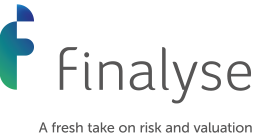Why is it necessary?
The need for an independent valuation is indisputable. It is crucial for any asset manager, banking institution, insurance company, or any other financial (and incidentally non-financial) institution to know the value of their assets as well as host of other assets on market that they are potentially interested in, so as to be able to make sound investment decisions. As the nature and a sole quality of the abstract “asset” is to bear (or to promise a possibility of bearing) some value at some point of time , the ability to be able to precisely and non-controversially estimate the fair value of the assets in the present time is an indispensable part of sound risk management.
Recent developments of regulatory requirements have compelled market participants to calculate not just a price but also indicators of the current and future behaviour of their products. The challenge of the day is to have a fair value (as to comply with IFRS standards and exchange variation margin) but also risk classes (for PRIIPS and UCITS), scenarios (Solvency II and PRIIPS), Stress tests (EBA and Solvency II), VaR (for AIFM), risk weights and exposure (for FRTB) and initial margin (for EMIR).
The question behind the valuation therefore never was if, but how.
The sole driver of the valuation should be a genuine desire to find the true value of the asset. Even somebody who wants to swindle their trade partners by claiming a false value of an asset should be interested in knowing its true value as to know the expediency of their activity. At least for themselves, it is within the self-interest of any asset holder – even an outwardly dishonest one - to evaluate the assets they are holding, willing to buy or sell as precisely as possible. Obviously, a vast majority of people in the market are honest, but as Akerlof’s market for lemons suggests, even (and especially) the honest sellers are hurt by a sheer possibility of bad apples.
For many practical reasons, such as moral hazard of individuals, asymmetric information between buyers and sellers, and companies cooking the books in order to escape or artificially satisfy regulatory requirements, it is not quite obvious that financial institutions, particularly if parties to a trade, would not end up “deluding” each other. Worse yet, as this delusion needs not to be intentional, institutions may end up having deluded themselves with purpose-built, biased or straight up false valuation. This may have far reaching consequences, particularly if a host of small self-delusions accumulate to form a large one that will then suffer a painful encounter with reality.
In order to avoid mistakes, whether by omission or commission, the regulators demand that the financial assets should be valued independently, that is by a party that does not have any interest in the transaction or its aftermath. It is not always prohibited for the companies to do the valuation of their own assets but it is seldom recommended. The department performing the valuation must be completely separate, both information-wise and incentive-wise, from the activity around the valued asset, making this arrangement rather demanding with regards to governance structure.
Nevertheless, the separation is not the end to all problems. Although it has been previously stated that knowing the value of assets is paramount to navigating a financial landscape with any degree of adroitness, it was never said that such knowledge is easily acquired. In explaining that something is not difficult, we often employ the phrase “it is not rocket science.” We use the Aerospace engineering as a standard for a novel, difficult and highly technical field. However, pricing derivatives is even more novel, less predictable and often no less technical nor difficult. When creating their famous (and from today’s standpoint overly simplistic) option pricing model, Black and Scholes took inspiration straight from the books of aerospace engineers. For all intents and purposes, the asset valuation either IS rocket science or is scarcely less complicated.
Whereas ten years ago the greatest challenge was to develop a proper model to capture the volatility smile, the long-term interest rates or the correlation, now the attention has shifted to capturing the so called XVA and exact profitability of a trade. Participants want to have a price that reflects all costs of each trade, including: counterparty risk, funding, capital requirement and margin, a challenge for the current generation of traders and quants or painful headaches for valuation teams.
There is a number of other significant challenges related to market data that the industry is facing: new curves and a new custom index are only a couple of examples. The time when we could use a single rate curve per currency is long gone, and so is the OIS discounting; now each CSA requires its own curve so that each time, one curve per counterparty and one per currency is needed at the very least.
As we have seen, the valuation rests on a number of assumptions. If its results are to cause more good than harm, it is essential to have an understanding of not only the final value, but also of the process with which it was achieved and what would happen if certain assumptions were relaxed, taking into account the ever changing nature of the financial markets and the fact that many underlying assumptions may change, and some will change, throughout the life of the asset.
In-house or externally?
The requirements for IT infrastructure, data and expertise necessary for performing valuation are severely prohibitive. It is difficult to automate the process as every individual asset needs a customized treatment and problems with data or regulatory changes are more a rule than an exception in this field. Few are the companies that can afford to have a dedicated valuation team that would be up to the task and even fewer still have possession of asset types so numerous and so diverse, that would render the cost of maintaining such team economically viable. All the rest may choose, to the extent that regulation allows it, to resign themselves to the fates of intuitive, rather than informed investors, or to rely on specialized third party valuers, who have no problem convincing regulators that they face no conflict of interest nor moral hazard, need not spare any expense on expertise and can make use of economies of scale to provide valuation for multiple asset managers and a large host of differing assets for a reasonable price. In addition, specialized valuers often do not just provide numbers, but also support, maintenance and explanations as well. The choice between performing valuation inhouse and outsourcing it to a third party is often a non-question; some regulators including the French AMF perceive independent in-house valuation as a contradiction in terms and do not completely allow it.
How is valuation performed?
The valuation of the assets rests on providing the present value of all possible future cash streams provided by the asset, subject to the probability of their occurrence and time value of money. A first step is to consider the asset type as well as the type of the underlying asset, as to be able to use the appropriate model. Different asset types (such as fixed-income instruments, options or equity) require a very different model in order to find their values. When an appropriate model is selected, a payoff structure of the given asset needs to be considered. There is nowadays little controversy about which models are appropriate for which asset type and consequently, the selection of an appropriate model is a relatively simple matter, once the IT structure and the expertise is in place. Today, funding and financing activities are affected by a range of factors, including global regulation on capital and liquidity management and of course market conditions such as the European Central Bank’s asset purchasing programme (APP) and negative interest rates. Having selected the appropriate model, the next step is to feed data to the model. Getting the right data in a consistent and unbiased manner is, by far, the most challenging part of the valuation process. For some types of illiquid assets, such as proprietary indices that are held rather than traded, the information is simply not available. The information gathered by the mainstream providers of data such as Reuters or Bloomberg is supplemented with data gathered from the brokers (particularly on volatilities). When unavailable, a host of simulations and proxies have to be used, making sure that they reflect the behaviour of the underlying asset as much as it is possible. Here in Finalyse, we have our own proprietary methodology of calculating proxies for certain parameters such as spreads for illiquid bonds or funding curves, that are a better fit for the appetite of banks than the data publically available (if at all available). Having acquired the best available market data to feed the model, the model will be calibrated using this data so as to capture as much of the behaviour of a given asset as it is possible.
Support and Reconciliation
The work isn’t over with the fair values and all the related information being accurately calculated and documented; they still need to be justified to the audit, regulators and counterparties. All assumptions and inputs, both used in the present and in the past, need to be clearly stated. This is especially true if there are price discrepancies between our valuation and a counterparty valuation. In those instances comes a somewhat challenging, but crucially important part: the reconciliation and dispute resolution. The objective of the reconciliation is to understand the reasons for the discrepancy. All parameters should be checked and compared with those of the counterparty in a fully transparent approach. However, the devil is in the detail. For example, for a foreign exchange deal, a small difference in market data snap time can cause severe deviations. Getting the right answers can often be quite challenging. Fortunately, the EMIR ISDA protocol and the mandatory reconciliation of derivatives are of great help getting all parties around the table. The ultimate goal is to understand and document in what way the valuations differ, so as to promote trust and transparency between the parties.
Valuation in practice
As much as the valuation indeed does primarily consist of providing the value for which the Structured products or Derivatives would sell on the market, the valuation service also (and perhaps to a greater extent) consists of cultivating a trust between the counterparties of the transaction as well as a security in the knowledge that they are on the same page. Having an expert who is independent from the transaction helps building this trust immensely. In addition to the “Premium” valuation, we thus also provide all the implied information that is also necessary to manage a product in goodwill.
Finalyse has developed a Regulatory compliance service dedicated to Derivatives which consists of providing:
- The Greeks
- Scenario analysis
- P&L explainer
- Stress-test
- SCR-stress-test for Solvency II
- EBA Stress Test
- AIFMD reporting
- EMIR Reporting
- Variation Margin calculation based on SIMM
- Collateral management
Finalyse InsuranceFinalyse offers specialized consulting for insurance and pension sectors, focusing on risk management, actuarial modeling, and regulatory compliance. Their services include Solvency II support, IFRS 17 implementation, and climate risk assessments, ensuring robust frameworks and regulatory alignment for institutions. |

Our Insurance Services
Check out Finalyse Insurance services list that could help your business.
Our Insurance Leaders
Get to know the people behind our services, feel free to ask them any questions.
Client Cases
Read Finalyse client cases regarding our insurance service offer.
Insurance blog articles
Read Finalyse blog articles regarding our insurance service offer.
Trending Services
BMA Regulations
Designed to meet regulatory and strategic requirements of the Actuarial and Risk department
Solvency II
Designed to meet regulatory and strategic requirements of the Actuarial and Risk department.
Outsourced Function Services
Designed to provide cost-efficient and independent assurance to insurance and reinsurance undertakings
Finalyse BankingFinalyse leverages 35+ years of banking expertise to guide you through regulatory challenges with tailored risk solutions. |

Trending Services
AI Fairness Assessment
Designed to help your Risk Management (Validation/AI Team) department in complying with EU AI Act regulatory requirements
CRR3 Validation Toolkit
A tool for banks to validate the implementation of RWA calculations and be better prepared for CRR3 in 2025
FRTB
In 2025, FRTB will become the European norm for Pillar I market risk. Enhanced reporting requirements will also kick in at the start of the year. Are you on track?
Finalyse ValuationValuing complex products is both costly and demanding, requiring quality data, advanced models, and expert support. Finalyse Valuation Services are tailored to client needs, ensuring transparency and ongoing collaboration. Our experts analyse and reconcile counterparty prices to explain and document any differences. |

Trending Services
Independent valuation of OTC and structured products
Helping clients to reconcile price disputes
Value at Risk (VaR) Calculation Service
Save time reviewing the reports instead of producing them yourself
EMIR and SFTR Reporting Services
Helping institutions to cope with reporting-related requirements
Finalyse PublicationsDiscover Finalyse writings, written for you by our experienced consultants, read whitepapers, our RegBrief and blog articles to stay ahead of the trends in the Banking, Insurance and Managed Services world |

Blog
Finalyse’s take on risk-mitigation techniques and the regulatory requirements that they address
Regulatory Brief
A regularly updated catalogue of key financial policy changes, focusing on risk management, reporting, governance, accounting, and trading
Materials
Read Finalyse whitepapers and research materials on trending subjects
Latest Blog Articles
Contents of a Recovery Plan: What European Insurers Can Learn From the Irish Experience (Part 2 of 2)
Contents of a Recovery Plan: What European Insurers Can Learn From the Irish Experience (Part 1 of 2)
Rethinking 'Risk-Free': Managing the Hidden Risks in Long- and Short-Term Insurance Liabilities
About FinalyseOur aim is to support our clients incorporating changes and innovations in valuation, risk and compliance. We share the ambition to contribute to a sustainable and resilient financial system. Facing these extraordinary challenges is what drives us every day. |

Finalyse CareersUnlock your potential with Finalyse: as risk management pioneers with over 35 years of experience, we provide advisory services and empower clients in making informed decisions. Our mission is to support them in adapting to changes and innovations, contributing to a sustainable and resilient financial system. |

Our Team
Get to know our diverse and multicultural teams, committed to bring new ideas
Why Finalyse
We combine growing fintech expertise, ownership, and a passion for tailored solutions to make a real impact
Career Path
Discover our three business lines and the expert teams delivering smart, reliable support


